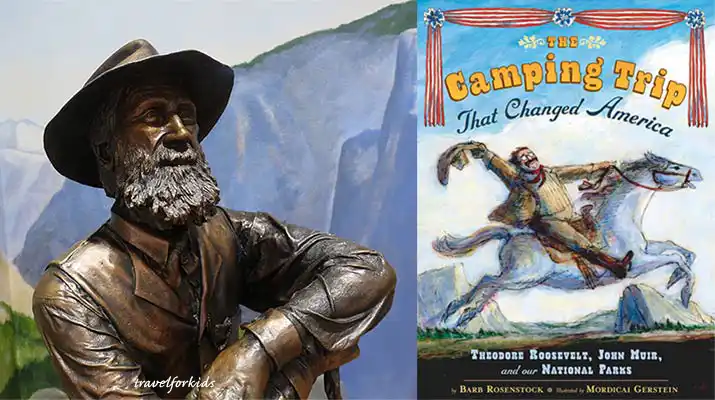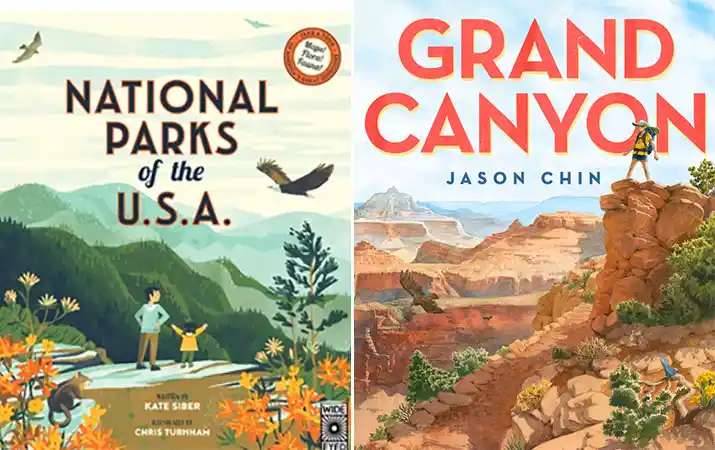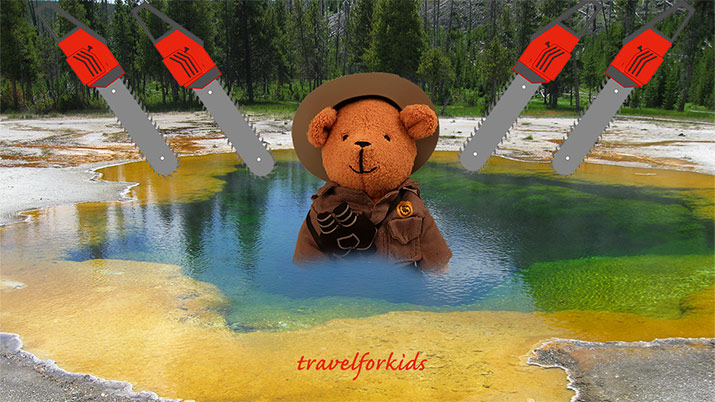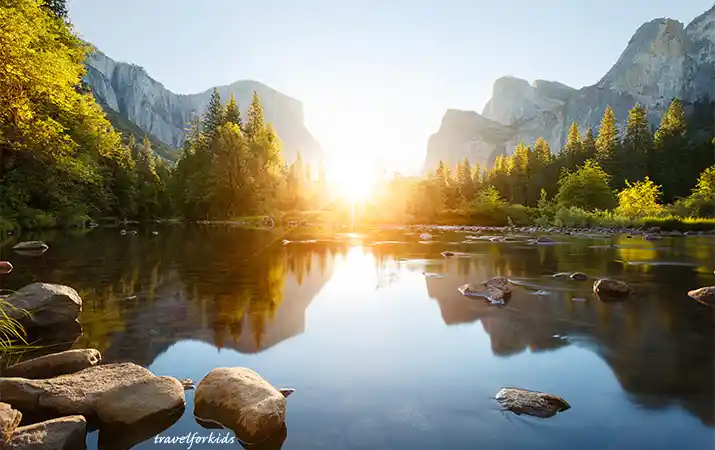John Muir is famous for helping create national parks, open to everyone, and his books about nature and wilderness conservation.
In March 1903, President Teddy Roosevelt read John Muir’s book The Mountains of California. In the book Muir advocated for help to preserve wild forests.
Roosevelt arranged for a camping trip to Yosemite with John Muir to see these trees for himself. Hiking on their own and sleeping outdoors, they stopped at the Mariposa Grove of giant sequoias.
John Muir explained giant sequoias “are the largest living things on earth. They never stop growing – unless they are cut down.”
Muir asked Roosevelt to make wilderness accessible to everyone and preserve these forests for future generations.
After this camping trip, Roosevelt created federal protection for public lands, national monuments, historic sites, indigenous cultural heritage sites, and expanded national parks.
Books about America’s national parks
John Muir and Teddy Roosevelt’s vision of national parks now includes over 400 wilderness parks, monuments, memorials, marine preserves, famous battlefields, historic forts, islands, caves, volcanoes, archaeological sites.
Here’s a few of our favorite books about national parks to inspire your next family vacation.
- National Parks of the U.S.A. by Kate Siber, Chris Turnham.
- Take a coast-to-coast journey of America’s national parks, from the Everglades to fossil-filled Badlands, condors in the Grand Canyon, hot and dry Death Valley, Bryce Canyon hoodoos, Mesa Verde cliff dwellings, Olympic rain forests, Hawaii volcanoes, and more, maps and facts about each park. Lots of unusual, fun details, beautifully illustrated. (Picture book)
- National Parks Guide USA by National Geographic Kids.
- Planning a trip to the national parks, this is comprehensive overall guidebook to many national parks, monuments, and historic sites. Filled with activities, hiking, camping, biking in each park, ranger tips for your visit, excellent detailed maps, wildlife to look for, excursions near the park. (Guidebook)
- Grand Canyon by Jason Chin.
- Take a walk through the Grand Canyon, to discover its amazing geology, plants and animals, starting at the bottom with the oldest formations. Gorgeous illustrations of how it might have looked millions of years ago, oceans that covered the canyon, fossils preserved in rocks, animals of each zone, capture the wonder of the Grand Canyon. (Picture book)
- What I saw in Grand Teton by Julie Gillum Lue, Christopher Cauble.
- Kid’s guide to wildlife, peaks, lakes, rivers, flowers, trees in Grand Teton, and also keep track of different animals you’ll see. Info and photos about moose, bison, pronghorn, elk, mule deer, beaver, black bear, bald eagle, osprey, red squirrel, white pelican, and where to locate the wildlife – very handy! (Picture – Activity book)
- Yellowstone Treasures by Janet Chapple.
- Our favorite guidebook to Yellowstone National Park – detailed descriptions of the five main roads through the park, nature trails, geyser basin walking tours, driving distances, geological history, animals to look for, photos, color maps, campgrounds. (Guidebook)
- So Big! Yosemite and So Small! Yosemite by Melissa Iwai.
- “How big is Yosemite Falls, how small is a sequoia cone,” delightful introduction to Yosemite landscape and wildlife for toddlers, beautifully illustrated! (Board books)
- The Camping Trip That Changed America by Barb Rosenstock, Mordicai Gerstein .
- Ride with President Teddy Roosevelt and John Muir through Yosemite in May 1903. Hiking on their own and sleeping outdoors, even when it snowed in May, it was simply glorious. After the camping trip, Roosevelt used his presidency to create federal protection for wilderness. (Picture book)
- Wildheart: The Daring Adventures of John Muir by by Julie Bertagna, William Goldsmith.
- Biography of John Muir, growing up in Scotland and the Midwest, coming to California. After John Muir first saw Yosemite Valley, he was so enchanted he spent years exploring the mountains, observing glaciers, wildlife, plants and trees in the Sierra Nevada. From his experiences in Yosemite, John Muir began his life’s work to preserve the wilderness.
- He is an inspiration to enjoy the wonders of nature, and be caretakers of the earth for future generations. (Graphic novel)
- The Adventures of John Muir by Kate Coombs, Seth Lucas.
- John Muir walked to see
Big, big trees.
“Come see what I see!” John Muir said
And people did. - What did John Muir see when he explored the mountains of Yosemite?
Books about John Muir
Read about the life and adventures of John Muir and his vision of nature that transformed the American wilderness.
John Muir National Historic Site
John Muir is noted for his daring outdoor adventures, but he was was also a devoted family man, living with his wife and two daughters on a large fruit ranch, east of San Francisco.
Today kids can can visit the Muir family home, run around the green orchards and flowering plants in spring (bring a picnic), and hike up Mt. Wanda, just as Muir did with his daughters.
For more info about visiting John Muir Historic Site, read our blog post: John Muir at Home.
National Parks and Lands Today
We love our national parks and lands owned by the public, and hope they will be preserved for our children’s children and generations beyond.
Update: Since January 20, 2025, the government has fired thousands of national park and forest service employees, which will have harmful consequences. Also there is currently a bill in Congress to allow chopping down old growth redwoods on forest service lands.
Read our blog post: Summer 2025: Tips for visiting US national parks
As John Muir said, “Any fool can destroy trees. They cannot run away, and if they could, they would still be destroyed – chased and hunted down as long as fun or a dollar could be got.”
It is a disaster to allow our public lands and cultural heritage to disappear forever to make a quick buck or please a clueless king.
“We are not building this country of ours for a day. It is to last through the ages” – Teddy Roosevelt, 1903.
Here’s to John Muir for a timeless legacy of conservation, and Teddy Roosevelt, who used his presidency to preserve and protect our wilderness, not destroy it.




